business background
With the continuous advancement of science and technology and the continuous development of laboratory management needs, traditional laboratory management methods are facing many problems, such as the use of paper records and manual operations, easy loss of data and difficulty in tracing, low efficiency, complex processes, and insufficient quality management. Specifications etc. These problems have become bottlenecks restricting laboratory development and improving operational efficiency. At the same time, the inspection and testing industry also faces the following challenges: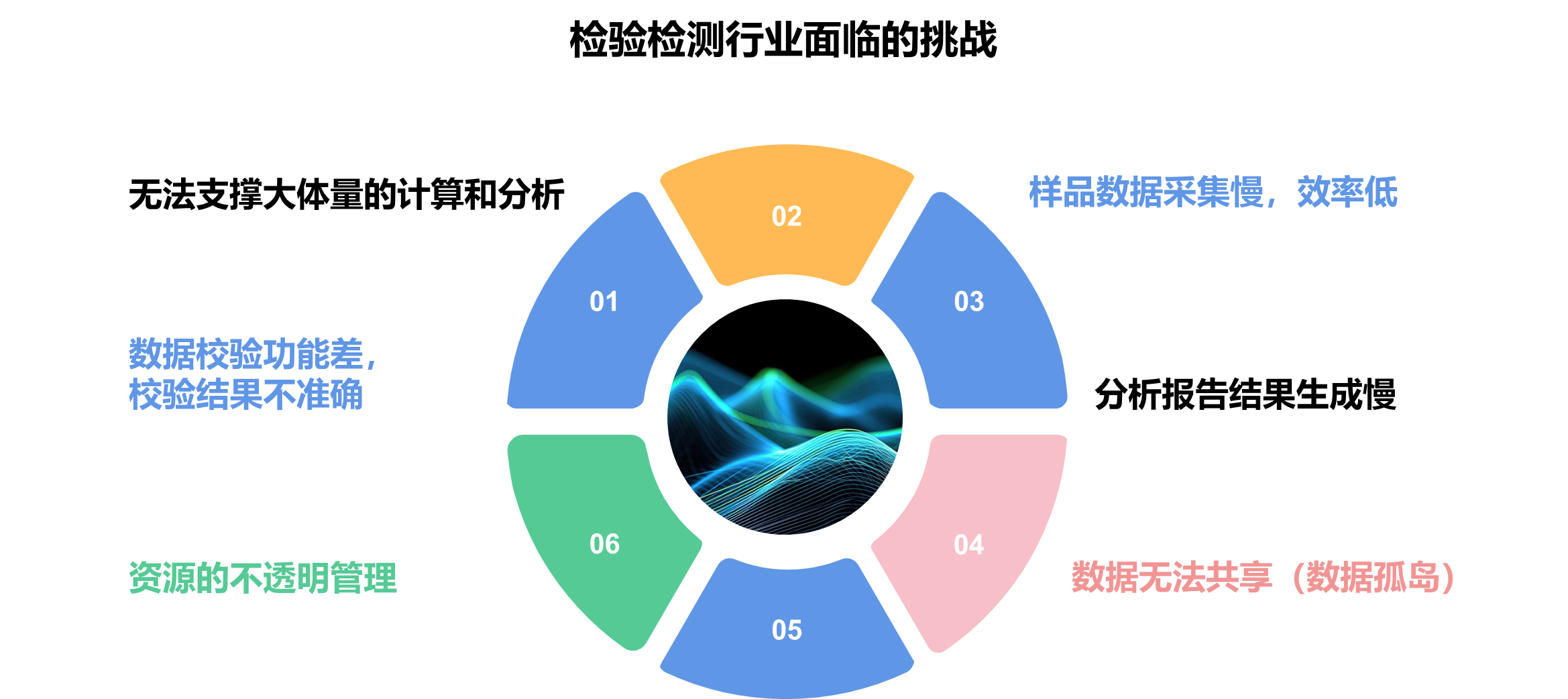
(1) Unable to support large-scale data calculation and analysis**: In the early experimental data analysis calculations, the amount of data was small, and simple calculators and manual calculations were sufficient. However, as the amount of detection data increases, the early calculation methods can no longer meet the demand, and data analysis tools with better performance and stronger computing power need to be introduced.
(2) Sample data collection is slow and inefficient: **Before digitization, traditional data collection relied on manual data information collection. The paper-based collection method was slow in efficiency and had poor preservation.
(3) Poor data verification function and inaccurate verification results: **The traditional working mode may have problems such as incomplete data verification, too loose verification rules, and logical loopholes in the algorithm, resulting in inaccurate verification results. , affecting the validity and credibility of the data.
(4) Analysis report results are generated slowly and cannot meet user needs: **Early systems cannot meet the growing demand for today's data volume. Their performance when processing large-scale data is poor, resulting in analysis report generation taking a long time and unable to meet users' needs. The need for fast, real-time analysis and reporting.
(5) Opaque management of resources: **In laboratory work, information on sample consumables needs to be recorded manually in the traditional way and saved in paper files. This will lead to problems such as unclear preservation and traceability, failure to form a system for personnel training materials, and difficulty in controlling file permissions. The transmission of test reports and test data requires paper delivery, which not only wastes resources but also cannot guarantee the authenticity and timeliness of the data.
(6) Data cannot be shared (data island): **Data cannot be communicated between laboratories. For example, it is difficult for the quality management department to call the testing data of each laboratory, and data is easily lost. It is difficult to dig deep into the value.
How to solve these pain points
In order to solve these problems and challenges, digital systems have gradually become a trend in laboratory management and are gradually applied to laboratory management. Laboratory Information Management Systems (LIMS) came into being. The LIMS digital system can realize the digital collection, management and analysis of laboratory data and improve the reliability and accuracy of data. At the same time, it can optimize laboratory workflow, improve management levels and quality certification levels.
Laboratory Information Management System, also known as LIMS (Laboratory Information Management System, hereinafter referred to as LIMS), is composed of computers and application software and can complete the collection, analysis, reporting and management of laboratory data and information.
LIMS系统以实验室为中心,将实验室的业务流程、环境、人员、仪器设备、标物标液、化学试剂、标准方法、图书资料、文件记录、客户管理等等影响分析的数据因素有机结合起来,采用先进的计算机网络技术,数据库技术和标准化的实验室管理思想,组成一个全面、规范的管理体系,为实现分析数据网上调度、分析数据自动采集、快速分布、信息共享、分析报告无纸化、质量保证体系顺利实施、成本严格控制、人员量化考核、实验室管理水平整体提高等各方面提供技术支持,是连接实验室、采样现场、监管部门及客户信息的信息平台,同时引入先进的数理统计技术,如方差分析、相关和回归分析、显著性检验、累积和控制图、抽样检验等,协助职能部门及时发现和控制影响产品质量的关键因素。
The introduction of LIMS digital system can greatly simplify the laboratory management process. By replacing paper records and manual operations, the LIMS system can realize the electronic collection and storage of experimental data, avoiding the problems of data loss and difficulty in traceability. At the same time, the automation function of the LIMS system can speed up laboratory processes, improve work efficiency, and reduce human errors and duplication of work.
Functional structure, inspection process and technical key points of LIMS system
This article only excerpts part of the plan. For more details, please click here to download the full version.
Functional structure
The digital LIMS application management system mainly includes the data layer, support layer, business layer and application layer. Among them, the data layer mainly includes detection database, report database and sampling information cloud database; the support layer includes authority authentication platform, detection result release platform, detection information release platform and business information platform; the business layer includes: standard management, contract management, personnel management , quality management, sampling management, instrument management, performance management, original analysis record management, reagent management, analysis method management, system management, etc.; the application layer mainly includes: testing business management platform, testing report release platform, and backend management platform. In addition, the digital LIMS application system also provides a standard data system and unified security standards to ensure the accuracy, consistency and standardization of data.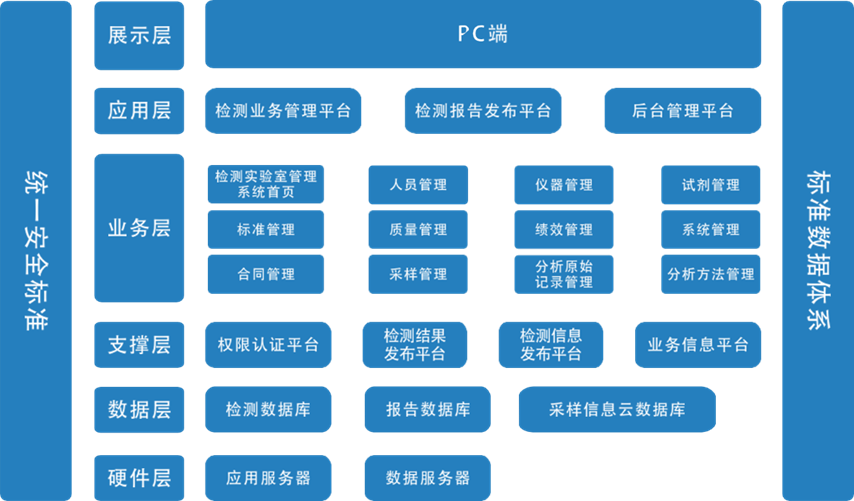
(Functional structure of LIMS system)
Inspection process
The inspection process of the LIMS system includes the following parts: customer management, contract management, sampling management, subcontracting management, resource management, quality control management, sample management, result entry, result review, report production and statistical analysis management.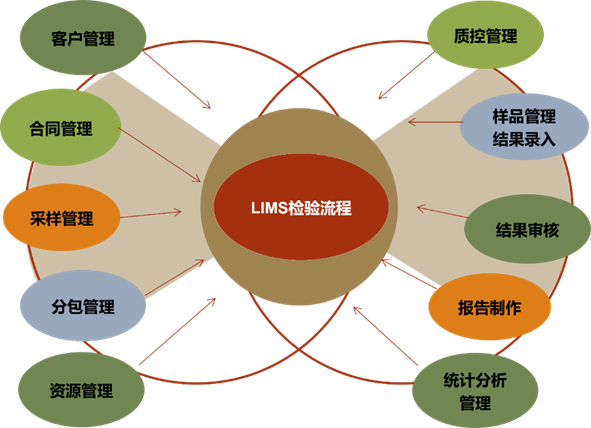
(Inspection process of LIMS system)
Technical points
(1) Multi-terminal cross-platform application
In the early LIMS system, report filling, modification and generation of inspection data were all completed through Excel. After entering the B/S era, LIMS systems need to be able to be used in real time on various terminal devices (such as computers, tablets, mobile phones, etc.). In this case, it becomes very inconvenient to fill in and modify data through Excel software. Therefore, how to directly operate reports on the browser and implement cross-platform applications is an important requirement for LIMS systems in the new era.
In the LIMS application system based on the browser/server (B/S) architecture, modules related to data filling, report analysis and display can be built based on front-end technology. With the help of SpreadJS, the pure front-end form control of Grape City Company, Excel can be migrated from offline to online, realizing the integrated process of data filling, analysis and report generation, and completely saying goodbye to dependence on Excel software. Through the nested technical solution, the system can realize the same form display method on the mobile terminal and desktop terminal.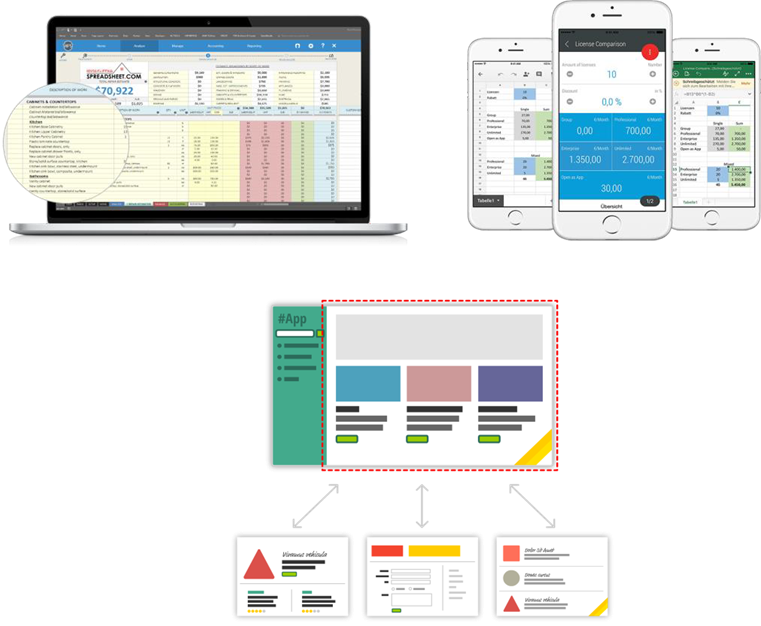
(Pure front-end, cross-platform)
(2) Excel-like operations
In the early days of laboratory data management, most users relied on Excel tools to complete data reporting, statistics, and analysis. In order to maintain a good user operating experience, the LIMS system based on B/S architecture needs to be as consistent as possible in data reporting, analysis and statistical operations. Grape City’s pure front-end table control SpreadJS can meet this demand very well. SpreadJS is a pure front-end table component based on the HTML5 standard. It has the characteristics of high performance, cross-platform, and high compatibility with Excel. This component can be embedded into the LIMS system in a native way to ensure the consistency of the system operation experience.
SpreadJS not only has a highly Excel-like interactive interface, but also has an operating experience that is highly consistent with Excel. This feature avoids the problems of difficulty in getting started with the system and cumbersome operations. While ensuring the efficiency of business personnel, it also saves a lot of user training costs for the enterprise and the implementation team.
(3) Diversified file import and export
In the inspection and testing industry, a large number of early inspection reports and raw data were recorded through Excel. In order to achieve the inheritance of historical data and efficient use of data, the data stored in Excel in the early days needs to be imported into the LIMS system; or the data in LIMS needs to be exported to other files such as Excel. SpreadJS is developed based on pure front-end technology. It can directly complete the import and export, PDF export, printing and preview operations of Excel, CSV, JSON and other files in the browser without the help of back-end code and third-party plug-ins.
Based on the support of SpreadJS's pure front-end file I/O capabilities, users can directly import existing Excel report templates into the front-end page for preview, secondary design, data filling or printing and other operations. This feature not only allows users to get rid of the dependence on the client Excel application, but also can easily break the data barriers between the system and Excel.
In terms of file printing, SpreadJS supports WYSIWYG print preview and PDF export functions, and supports interactive design of printing parameters, including paper, borders, paging, headers and footers, etc., which greatly improves the user's interactive experience.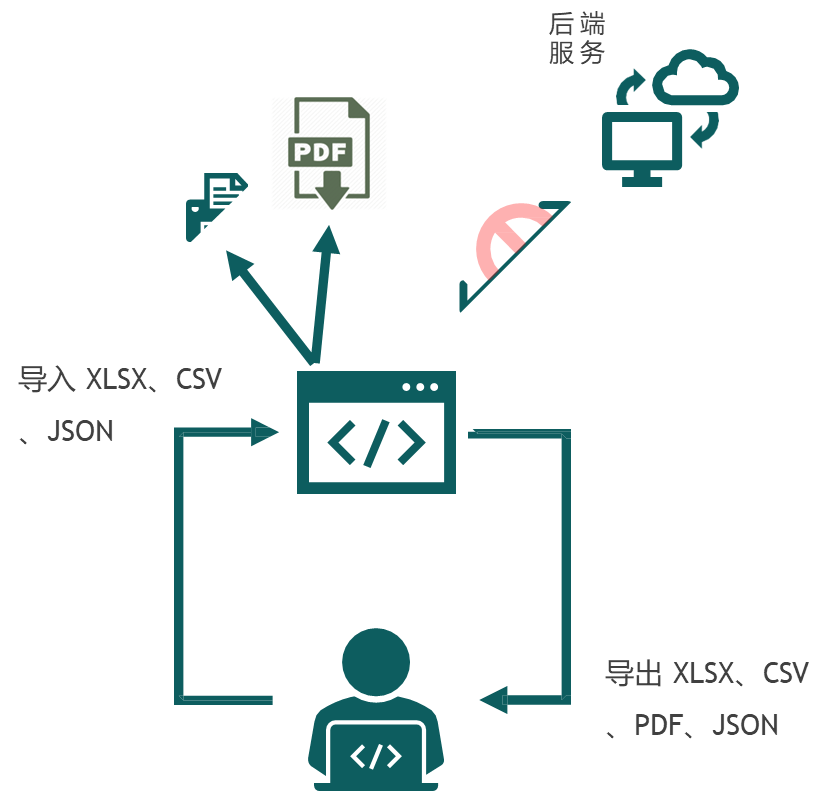
(File import and export)
(4) High processing performance and response speed
In detection systems, a large number of data loading and analysis functions are often involved. In terms of performance, SpreadJS has high-performance rendering capabilities, can load 100,000 rows of data in 100 milliseconds, and provides efficient grouping, sorting, filtering, column hiding and other functions. When performing the above operations, the system occupies very little memory, providing a smoother operating experience while meeting business needs.
In addition, SpreadJS can also provide good performance for document loading and formula calculation. SpreadJS supports pure front-end import of Excel files. For large-volume Excel documents, it can support lazy loading, incremental loading and other capabilities to improve user experience. In the formula calculation module, SpreadJS supports the pure front-end rendering capability of millions of data in seconds, and can load millions of data and calculation formulas with performance close to native Excel. At the same time, it also provides front-end and back-end combination solutions such as lazy loading and asynchronous formulas to further optimize loading and computing performance and improve the operating experience.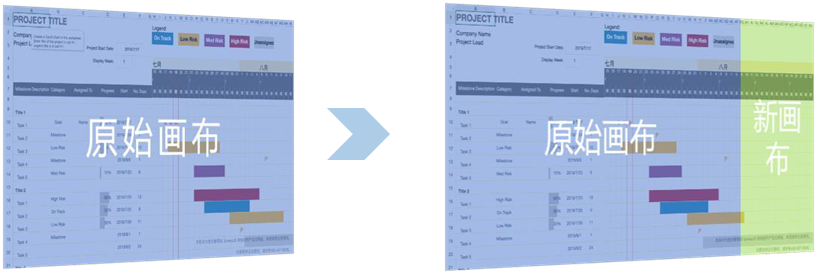
(HTML5 Canvas page drawing)
Value and Advantages
As an application technology for laboratory management and control in various industries that integrates modern management ideas and computer technology, the LIMS system can improve the management level of laboratories to a level compatible with the information age. Its emergence caters to the value needs of the testing industry in the following four aspects:
(1) Manage massive amounts of information : The emergence of LIMS systems can help organizations save laboratory data, assist laboratory quality assurance practices, and realize information exchange with other departments within the enterprise.
(2)加强质量保证:质量保证(Quality Assurance,QA)被定义为:”为了提供质量可靠的产品和服务而必须事先计划好的所有活动,它是对质量控制措施进行质量评价以及确定测定流程的有效性“。LIMS的出现可以显著的促进整个QA过程。
Through the LIMS system, laboratories can better control and monitor the integrity, accuracy and reliability of data, thereby further optimizing and strengthening laboratory quality control. Therefore, the application of LIMS system can be regarded as a necessary component of laboratory management. It can effectively improve the quality and efficiency of the laboratory, while also providing laboratory managers with more data and information for decision-making and planning. .
( 3) Reduce data entry errors : The emergence of LIMS provides a variety of security mechanisms to reduce data entry errors, such as:
(a) Data input restrictions: Specifies the input type and size range of data values.
(b) Range check: For example, when the input value exceeds a certain limit, a warning message is provided through sound or color.
(c) Automatic calculation: For a certain test method, LIMS will automatically calculate the result after obtaining enough information, thereby effectively reducing errors caused during data calculation and transmission.
(4) Shorten the sample analysis cycle : The emergence of LIMS speeds up the turnover efficiency of samples and reduces the time consumed in sample tracking.
(The value of LIMS system)
In the LIMS system, by embedding Xi'an Grape City Company's pure front-end table control SpreadJS, it further meets the system's needs in table scenarios. The reason is that SpreadJS brings the following advantages to the LIMS system:
(1) Powerful computing engine
SpreadJS 的计算引擎内置了513种公式函数,其中有459种与 Excel 兼容。这些函数涵盖了数组函数、动态数组、异步函数、XMATCH、LET、XLOOKUP、LAMBDA 函数等。除此之外,SpreadJS 还支持自定义特性,可以轻松进行扩展。这样的功能组合最大程度上满足了LIMS系统中的数据分析与计算需求,并且能够显著减少数据计算错误的发生。无论是复杂的数据分析还是精确的计算,SpreadJS 提供了强大而可靠的工具,为LIMS系统的数据处理提供了可靠的支持。
(2) Industry-leading Excel compatibility
SpreadJS has built-in 18 conditional formats, 32 charts, 53 cell formats and 182 shapes. It fully supports Excel data formats, meets user needs to the greatest extent, and allows the LIMS system to easily obtain near-native results in table scenarios. Excel functions and experience.
(3) Online import and export of Excel
SpreadJS is developed based on pure front-end technology. It can directly complete the import and export, PDF export, printing and preview operations of Excel, CSV, JSON and other files in the browser without the help of back-end code and third-party components. Not only can it achieve cross-platform file I/O capabilities, but it can also greatly reduce the pressure on the LIMS system server to parse and transmit files when the amount of concurrency is high.
(4) Extremely high processing performance
SpreadJS uses HTML5 Canvas to implement table drawing, which avoids the rendering performance bottleneck caused by traditional DOM splicing. This table drawing solution has won the national invention patent certificate and can provide a smooth user experience and excellent performance. This ensures that the LIMS system can still maintain a stable operating status even when the amount of data is large.
(5) Pure front-end, cross-platform
SpreadJS is based on the HTML5 standard, supports cross-platform development and integration, and supports all major browsers.
(6) Framework and expansion capabilities 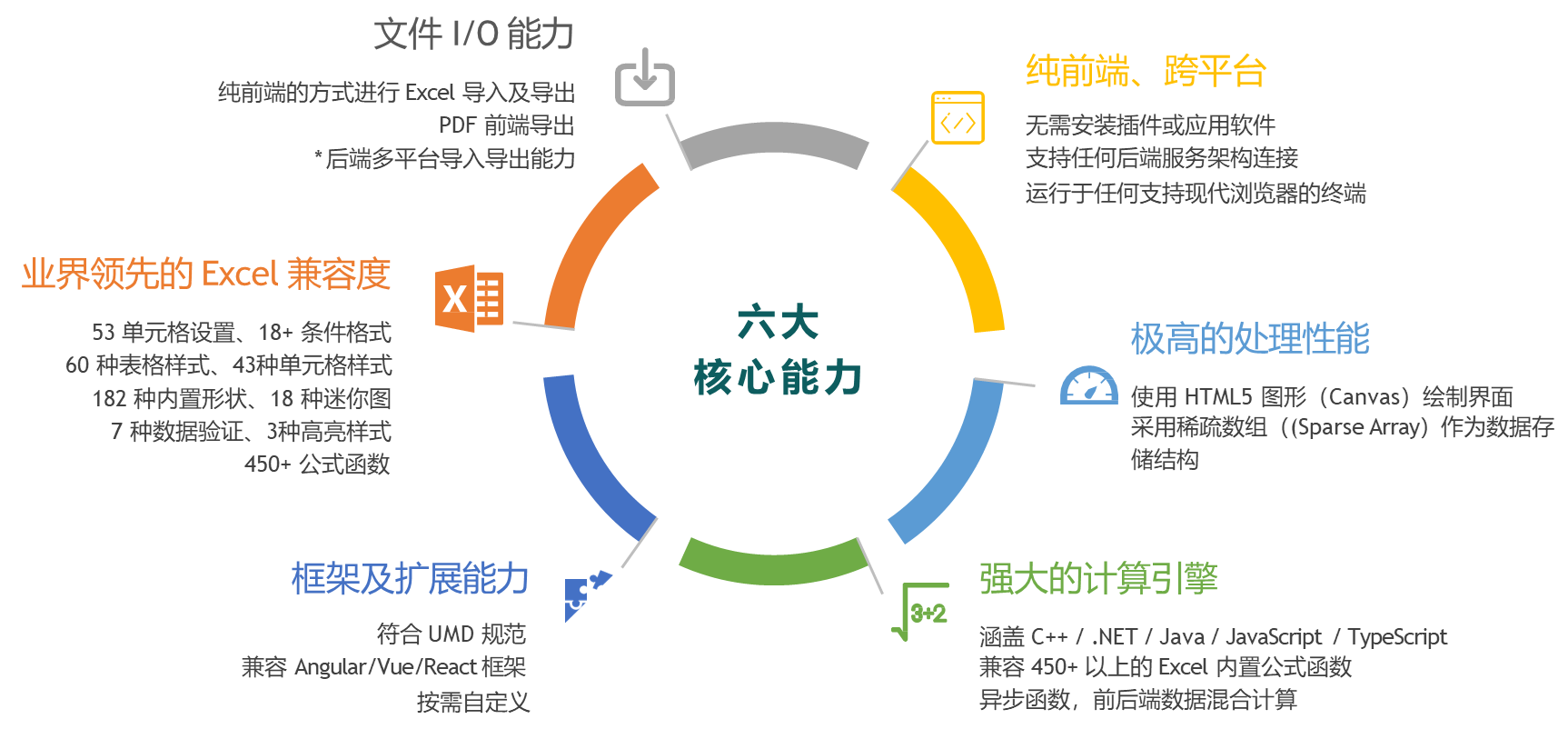
(Value of SpreadJS)
SpreadJS complies with the UMD specification and is compatible with the Angular/Vue/React framework, which can satisfy the development environment of the LIMS system to the greatest extent.
Please click here to obtain the full version of the "LIMS Digital System Solution White Paper". Welcome to call 400 657 6008 or go to the Grape City official website to download and try SpreadJS for free.
Linus took it upon himself to prevent kernel developers from replacing tabs with spaces. His father is one of the few leaders who can write code, his second son is the director of the open source technology department, and his youngest son is an open source core contributor. Robin Li: Natural language will become a new universal programming language. The open source model will fall further and further behind Huawei: It will take 1 year to fully migrate 5,000 commonly used mobile applications to Hongmeng. Java is the language most prone to third-party vulnerabilities. Rich text editor Quill 2.0 has been released with features, reliability and developers. The experience has been greatly improved. Ma Huateng and Zhou Hongyi shook hands to "eliminate grudges." Meta Llama 3 is officially released. Although the open source of Laoxiangji is not the code, the reasons behind it are very heart-warming. Google announced a large-scale restructuring